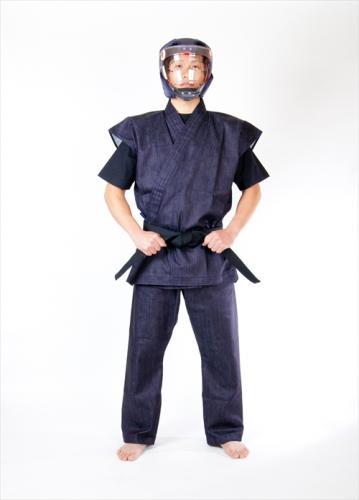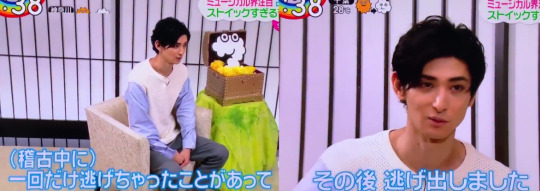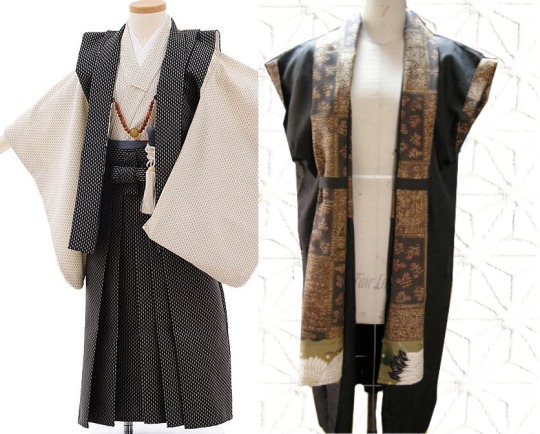#sodenashi haori
Explore tagged Tumblr posts
Note
Hello! I've been following your blog for a few years because I love traditional Japanese fashion, it's silhouettes, patterns, and color choices (also how people across the ages wear their clothes and how they're built) and this is my first ask!
I'm not sure if you watch Jujutsu Kaisen but I've been wondering about a specific farmer a character wears; Kamo Choso wears this deep purple vest with an interesting waist. I'm wondering; does this particular garment have a name/historical origins? Or is it more *fantasy fashion*?
Thank you so much for your consideration for my question.
Hi lurker ;) and thank you for following for so long!
As for your ask, for reference, here's what Chôsô from Jujutsu Kaisen wears:

My first impression was that the purple overvest could be a sleeveless haori (sodenashi haori 袖無羽織) cinched with a large matching belt. Might also be a 胴着 dôgi (historically those were kind of sleeveless thick undershirts worn under kimono for warmth, and sometimes used as cloak/vest). But tbh those doesn't feel quite right ^^;
Considering the martial elements of Jujutsu Kaisen, 稽古着 keikogi (or 道着 dôgi) is a better candidate, as those are the "uniforms" for Japanese martial arts like judo, aikido, ... and jujustu ;)
Simply refered as "gi" in English, keikogi is a pretty modern wear and shapes widely varies depending on the discipline. Here is a sleeveless example:

(pic source)
#ask#jujutsu kaisen#kamo choso#cosplay#reference#gi#keikogi#dogi#sodenashi haori#sleeveless#haori#sleeveless vest#Japanese martial arts#着物#帯#羽織
51 notes
·
View notes
Note
Hi Chibimyumi! Can you please give examples of Yuta's thoughts about social struggles ( mental health, gengered bias etc.) ^-^ And what do you think about FuruTod's dress?
Hello Anon ^ω^
I would gladly!
Mental Health
Furukawa does not actually talk about mental health outside his own scope at all; he keeps everything on a personal level only.
He is fairly strict to himself; Furukawa seems to value problem-tackling way more than self-therapy. I have never seen him comfort himself with mental hacks or softness; whenever there is a problem he would call everything for what it is without any sugar coating. Examples include him referring to his actions using the words ‘cowardice’, ‘weakness’, ‘arrogance’, ‘naivety’, etc. Furukawa would not linger on these derogatory terms however. He accepts these as simply descriptors rather than ultimate identifiers. Having weaknesses does not make one weak, and sugar coating problems is counterproductive to combating them, after all.
An example of this is actually as recent as today (June 19th, 2019), where on the TV programme ZIP, Furukawa openly talked about himself running away from rehearsal, using the unapologetic word 逃げ出す (nigedasu・run/bolt away).

Furukawa also grew a lot in the recent years. In the past, rather than facing his obstacles head on, he would shamelessly ask others to solve the problem for him. He learned the consequences of this passive attitude the hard way, alas, but he did learn. And he is determined to let the lesson count. Likewise, he has also learned that a challenge is just a task that he might have to work harder for to take on, rather than be upset with himself that we was not ‘born to be able to do it’. In one interview where he was asked how he felt about being promoted to ‘Ogosho’ (Prince), now being ranked the same as other legendary performers, Furukawa answered as follows:
“I don’t have talents. Unlike Inoue-senpai (Inoue Yoshio), I can’t just open my mouth and hit notes so beautiful it moves people’s hearts. I am not like Iku-senpai (Yamazaki Ikusaburo) who can just stand there and suck people into the play with sheer charisma. But I believe that my weaknesses are my biggest weapon. These weaknesses keep me motivated to work harder than anyone, and I believe that my ardent hard-work is the soul of my performance. I hope that rather than ‘one show’, my performances can be a journey of growth that I share with my audience.” (*Starts sobbing* Furukawa, you are a beacon of inspiring energy T^T)
Furukawa is not some mental-health guru who gives advice, but in my opinion, he is incredibly effective because he leads by example. By always being open and casual about addressing weaknesses and problems, he reminds his spectators that it is not shameful to talk about these, and that the shame is only as big as one makes it to be. Likewise, he reminds people that there is no such thing as one rigid standard set in stone. ��Rather than setting a goal according to one’s ideals, I think it is more important to strive for flexibility in preparation for these ideals” [Link].
To me, it is especially extraordinary because he is a man, and therefore socialised to reject and spit on weakness, and be shamed for having such ““unmanly traits””.
Gendered Bias
Japan is an incredibly and infuriatingly gendered society (personal story; I myself wear incredibly girly clothes, but my “opinions” are probably not “girly” enough. Once I was just talking to someone, and they advised me to “not speak so scarily, instead I should speak cuter”, because it does not fit my femininity.)
Born and raised in the middle of nowhere in a very traditional household where his father was the absolute and only authority, Furukawa too grew up with rigid gender standards. As a result, Furukawa is not entirely without bias either of course, but he is always keeping his eyes open to check what bias there might be. He is a critical thinker, and unpacks the psyche behind a person’s behaviour to the bottom. This allows him to gain a more objective view on cause and effect in human behaviour. (The Sebastianess is real). This ‘unpacking’ is probably what helped him see through the artificialness of gendered conventions, and helps him check for bias. Perhaps it is this talent that made him so good at his job of producing amazing interpretations for his roles, perhaps it is his job which nurtured this talent. Or it’s both.
This is just me surmising, but it is likewise possible that he is so feminist because he does not feel sexual attraction for women (or anyone else); this probably helped him rationalise and shielded him from falling for the sexualisation of women which reduces them into a piece of meat to be owned.

In the after-talk show of ‘Marie Antoinette’ at the Imperial Theatre, Furukawa was asked what role other than Axel von Fersen he would have liked to play.
Furukawa: “M.A.” (the initials of the lead roles Marie Antoinette and Margrid Arnaud).
Host: “Which one?”
Furukawa: “Both. These women are amazing, but I cannot play them. This world is made by men for men like me, and yet, we all still manage to fail despite everything being customised by ourselves (laughs). What does success of a man even mean then? I admire women who have succeeded despite all the odds. If I were ever reborn as a woman, I want to play heroines like these people.”
(And the fans unanimously agreed that we don’t want him to reincarnate, we just want him to play these roles the way he is XD)
Without trying to point the finger to Japanese gendered society (too hard, with fully manicured nails and a new set or diamond rings), I am astonished by how emancipated Furukawa turned out despite his background.
Scary and Being Scared
Furukawa is hyper aware of the fearsomeness of toxic masculinity. He once admitted that he actually has trouble interacting with women, because he grows too self-conscious of being scary, and fears he might not be able to catch his own bad behaviour on time. He said that he is so tall he towers over even most men (in Japan) on top of having a villainous face. (???? Ô.ó) In addition, he said that his speaking voice is low to begin with, but when he is scared it becomes even lower, and he sometimes accidentally raises his voice. All in all, he said there is no reason for women NOT to be scared by him. So, he rather keep himself at bay.
In this post about Furukawa’s respect for women, we see how mindful he is in approaching women. Though this story is inspiring, it is possible this respect comes from a place of fear. Regardless, it is still rare to see a man so graciously acknowledging toxic masculinity AND admitting fear (fear for anything, really! And that’s why I love him).
In one of the old shows ‘Heat Up Eve’, Furukawa was talking about how hitting on girls is a very scary thing to do. He wondered how girls even deal with this. In the phoning-corner-event, Furukawa asked the calling fan how she would handle the situation, and his team-mates suggested him doing a live simulation with the fan. Furukawa agreed to put on his scary-face, and produced the following gem:
youtube

Der Tod’s Costume
I really, honestly like his standard costume a lot. In normal light I am not entirely sure, but in stage-light (as it is meant to be) it is a magnificent piece of art.

It is rather patriotic since TOHO already declared a “New Era of the Japanese ‘Elisabeth’ with their new Ogosho“, but I really like the details on his lapel that may have been based on a Sodenashi Haori.


His other costume for ‘The Last Dance’ is something I have not really made my mind up about, though I am happy to see him with a cape again. This vaguely Victorian-Napoleonic era uniform also has some Japanese factors in it, but I am not sure I like the breaks of the knots that don’t reach its buttons...

Though, I really like how his hair is tied back into a pony tail with a ribbon. Der Tod’s original visual design had shorter hair, but they aborted that idea. This pony-tail look with long bangs makes it look like the huge banners are not false advertisement XD.
Regardless, I am happy they finally made Furukawa his own costumes and dropped the previous costume that was Shirota Yuu’s (whose built is MUCH larger). It looked like YunTod was wearing his father’s clothes...
Inoue-senpai (left) also expressed how he was a bit jealous of Furukawa’s costumes, and joked:
“Furu-kun’s clothes are so elegant and refreshing, I think it reflects what kind of Der Tod he plays. Here I am carrying a dead fish tail; what does that say about me? (laughs)” [Source]

#Furukawa Yuta#Yun#YunTod#FuruTod#Mental Health#EVERYONE has weaknesses okay#Having them does not automatically make you weak#It's about how you deal with them#Fear#Anxiety#Gendered bias#Der Tod#Elisabeth#Das Musical#TOHO#Imperial Theatre#I LOVE HIM SO MUCH
44 notes
·
View notes
Photo


Playful outfit showing that men too can rock cute kimono ^^
That harinezumi (hedgehog) kimono by Mimizukuya has been paired with a see-thought sodenashi* (sleeveless haori) and a custom hedgehog haori himo (hoeri ties).
(*short of sodenashibaori. They are sometimes also called jinbaori but this is technically incorrect as jinbaori are special type of ancient battle surcoats)
#japan#fashion#kimono#men kimono#hedgehog#harinezumi#Mimizukuya#sodenashi#sleeveless haori#sodenashibaori#haori himo#着物#帯#jinbaori
718 notes
·
View notes